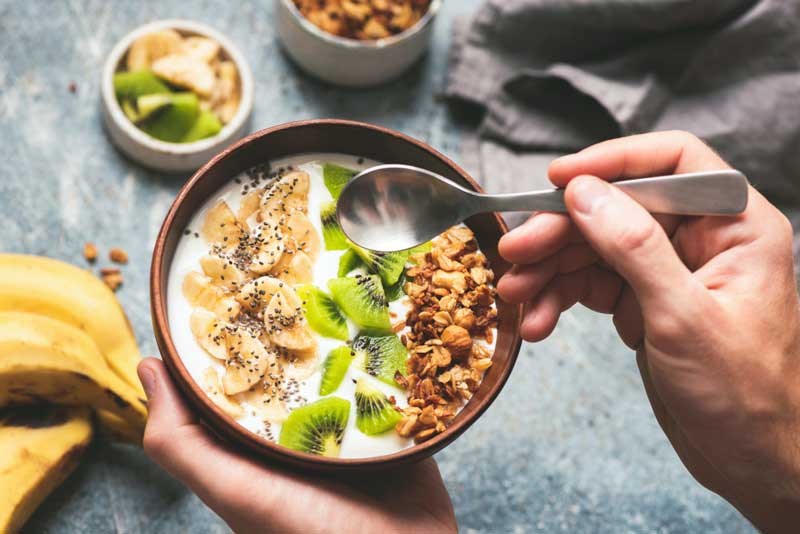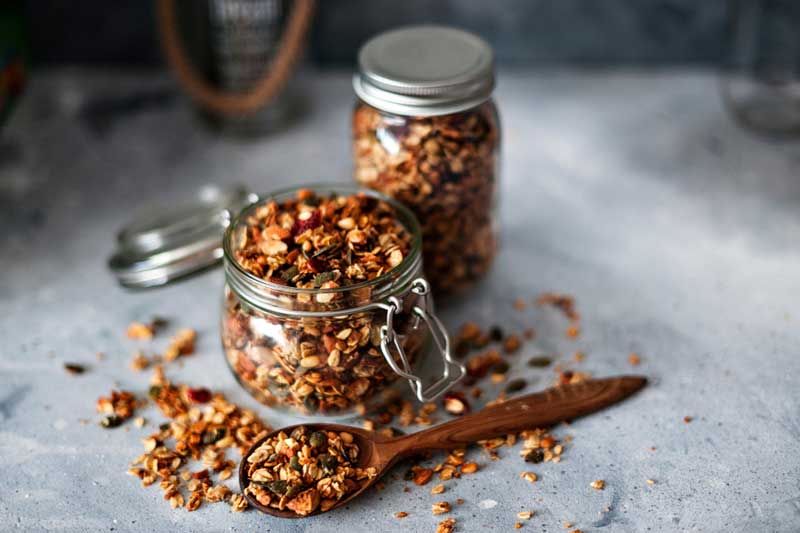Are you stuck with the question “Is granola gluten free?”
Granola has a long and fascinating history, even though some may think of it as a mediocre or dull foodstuff.
Dr. James Caleb Jackson created granola, often known as “granular,” in New York City in 1863. It was trademarked in the United States in the 19th century.
Initially, a foundation combination resembling cereal flakes was used to make granola. Later, producers added fruit and nuts to promote the product as nutritious.
However, oats were not introduced as granola until much later, substituting the cereal.
Granola is now a common element in many houses in the current era. It was initially used for breakfast but eventually in smoothies, baking, and other snacks.
Is granola gluten free? Let’s find out in the article below.
Is Granola Gluten Free?
Over the globe, granola is a terrific product that millions of people adore. It is lauded for its simplicity, usefulness, variety of flavors, health advantages, and price!
Oats are the primary component used to make granola. However, not all oats are, regrettably, gluten-free, mainly because there are so many fantastic flavors and applications out there!
The idea that oats are entirely gluten-free needs to be clarified. Only pure oats are, though.
Regrettably, relatively few granola producers employ only pure oats. Oats are also produced in bulk and frequently stocked among wheat goods, even though they are not made from wheat.
These fake oats include avenin, a protein that contributes to their gluten-containing nature. It is comparable to the protein present in wheat’s gluten.
This implies that those allergic to it may experience a similar reaction. Abdominal pain, bloating, exhaustion, and diarrhea, are just a few of the mild to severe symptoms brought on by a gluten allergy or intolerance.
Oats and its products cannot be tagged as gluten-free in several nations, such as Australia and New Zealand.
Moreover, regular wheat flour, which helps the ingredients come together, is found in many granola products. Wheat germ might even be included to promote it as a health product.
Even though this protein differs from oats, many people are intolerant.
The majority of granola varieties are, therefore, not gluten-free. But the world in which we live today provides a wide range of unique options.
What Is Granola?
Granola is a common element in many houses in the current era. It was initially used for breakfast but eventually in smoothies, baking, and other snacks.
Rolled oats, honey, nuts, and additional sweeteners like sugar are all combined to make granola. Nonetheless, countless varieties of granola recipes and goods are available because we live in such a creative and original age.
Dried fruit, nuts, various grains and cereals, and several flavoring elements are all common additions to this mixture.
Breakfast is when this product is most frequently consumed. It is combined with milk or yogurt. This helps to naturally moisten an otherwise dry bite by softening the oats.
To add extra taste and color, you can also add other toppings. One of our favorites is freshly cut fruit!
Then, you can make snack bars with granola. This is regarded as a quick and easy-to-prepare healthy on-the-go snack.
Granola bars are portable, affordable, and preportioned, making it simpler to control overeating.
In fact, according to several studies, preportioned foods help with weight management.
For instance, a 12-week study including 183 individuals discovered that adhering to a meal plan that called for eating preportioned items resulted in better weight and fat loss than following a typical self-made diet.
Additionally, granola bars might be nutritious since they contain oats, almonds, seeds, and dried fruit.
Oats are particularly abundant in beta-glucan, a form of fiber that can aid in lowering total and LDL (bad) cholesterol levels, both heart disease risk factors.
In the meantime, it has been demonstrated that nuts, seeds, and dried fruit are good for heart health and blood sugar regulation.
How to Tell if Granola Is Gluten Free
The back of the package is the best place to start for that. The ingredients list is typically followed by a list of frequently occurring allergies that are mainly listed. And, as wheat is generally among the world’s top 8 allergens, it is often included.
In certain nations, it is even required by law for products to list any common allergens they may contain.
Here are some things to look for when reviewing the ingredients list if you wish to double-check (especially if you are a celiac patient).
In the majority of oat-based granolas, oats are listed first. Then, keep an eye out for any wheat that is mentioned. They usually say “wheat,” even though they might not always specify the kind of wheat or its utilized product.
Remember that numerous wheat product varieties exist, including spelled farro, graham, and Kamut. They are frequently used for making granola as well.
Thus, instead of skipping over an ingredient you don’t recognize, quickly Google it. Some popular ingredients that also contain gluten include rye and barley.
How to Eat Granola

Breakfast With Granola
- Mix some oats before baking the pancakes for a unique twist on the breakfast staple.
- Add some granola to your toast. Toast slathered with peanut butter or chocolate-hazelnut flavor pairs well with chocolate granola.
- Sprinkle your preferred granola on top of your yogurt.
- Add some granola, including low-carb varieties, to your bowl of cereal for breakfast to give it a little more crunch.
- Combine your oatmeal with some granola.
- Add granola to your next smoothie bowl for some more depth.
Lunch With Granola
- Use Nutty No Grainer Original instead of batter or breadcrumbs when making chicken tenders. Use our savory granola, Nutty No Grainer Mediterranean blend, for a more flavorful version.
- To give texture to meatballs, meatloaf, or hamburgers, add Maple-Vanilla Granola.
- Sprinkle Original Nutty No Grainer on top of a salad.
Dinners With Granola Included
- Add some Ginger Granola to roasted yams to give them a little crunch.
- Sprinkle Pumpkin Granola or Go Nuts Granola on top of the roasted vegetables.
- Replace the granola in the filling with breadcrumbs.
- Granola can be an inventive soup topping instead of croutons.
- Sprinkle baked pears with rosemary, Maple-Vanilla Granola, and apples with Apple Cinnamon Granola.
Desserts With Granola
- Granola and fruit are a must-have addition to any yogurt parfait! If you enjoy this concoction, combine yogurt, granola, and berries into tiny clusters to make frozen yogurt bites. Eat and freeze. Make yogurt pops out of fruit and yogurt as an alternative, then top them with granola.
- To add aesthetic flair, sprinkle granola over cheesecakes, pies, cakes, and cupcakes.
- When you feel like a cool treat, indulge in ice cream with oats.
- Roll strawberries or bananas in nut butter (or a nut-free alternative) and sprinkle with chocolate granola for a sweet treat.
- Add granola to cake, brownie, or muffin batter.
Granola Snacks
- Top your go-to smoothie with granola.
- Make granola bars with honey, peanut butter, chocolate chips, and dried fruit. Use your preferred brand of granola, please!
Use Coconut Granola, offered in original and organic varieties, for a tropical taste. Our First Date Granola contains no added sugar and might interest those seeking a distinctive flavor.
- Granola, sweetener, and nut butter can be combined to make easy energy snacks perfect for on-the-go days. Place in the refrigerator, then just grab and go.
- The next time you need to refuel on an outdoor journey, add granola to your trail mix.
Granola: Easy To Take On The Go
Due to its convenience in storage and lengthy shelf life, granola has long been a favorite among hikers and backpackers.
It offers more energy and protein during endurance sports, similar to trail mix.
Granola snack bars are another more straightforward option to portion up and pack. On the other hand, they are frequently more processed and laden with extra sugars, oils, and additives.
Potential Health Benefits of Granola
- First, lower blood pressure. It has been demonstrated that high-fiber foods like oats and flax seeds can lower blood pressure.
- Lower the level of cholesterol. Beta-glucan, a type of fiber that works to lower total and LDL (harmful) cholesterol levels, both triggers for heart disease, is abundant in oats.
- Lower blood glucose. When a person has obesity or prediabetes, whole grains, dried fruit, nuts, and seeds may help lower and manage blood sugar levels.
- Boost intestinal health. Comparing granola to refined morning cereals, researchers discovered that the latter decreased levels of good intestinal bacteria.
- Provide lots of antioxidants. Anti-inflammatory antioxidants like gallic acid, quercetin, selenium, and vitamin E can be found in foods like coconut, chia seeds, and Brazil nuts.
Frequently Asked Questions – Is Granola Gluten Free?
Is a Granola Healthy or Not?
Protein and critical micronutrients, including iron, vitamin D, folate, and zinc, are all included in granola. Depending on the type and brand you select, serving sizes range from 1/4 cup to a full cup. Moreover, granola is a fantastic source of vitamin B.
Why Is It Called Granola?
Etymology. Genericization of Granula, a version of the cereal first created by James Caleb Jackson in 1863 under the name Granola. Graham flour, the primary ingredient, inspired the name Granula.
Is It Cheaper to Make Your Own Granola?
If you create your granola more than once, it will be less expensive. While buying all the components in bulk may be slightly more costly initially, homemade granola is significantly cheaper in the long term.
What’s Granola Made Of?
Often, whole oats, some nuts or seeds, and dried fruit are used to make granola. According to Nancy Clark, a registered dietitian and sports nutritionist based in Boston, oats are rich in fiber, which may help decrease cholesterol.
What Is the Best Way to Eat Granola?
A Few Ways to Enjoy Granola are Included Below:
- Make a Yogurt Parfait of your own. Making a delicious and energizing parfait with granola is one of the finest ways to consume it.
- Add it to baked goods.
- Create your granola bars.
- Give a bowl of cereal some crunch.
- Make protein-rich bites.
- Use a few handfuls in a smoothie bowl.
Do You Cook Granola Before Eating?
No more preparation is required; simply take a spoon and indulge!
Choose a variety of granola with a nutritious blend of components like nuts, seeds, and dried fruit to ensure your breakfast is balanced.
Specially blended packaged granolas can be found in the cereal section of many supermarkets.
Can You Eat Raw Oats as Granola?
Oats eaten raw are healthy and secure. They may help you lose weight, lower your cholesterol and blood sugar, and improve the health of your stomach and heart since they contain a lot of the soluble fiber beta-glucan. They are straightforward to include in your diet.
Conclusion- Is Granola Gluten Free?
Oats are the primary component used to make granola. However, not all oats are, regrettably, gluten-free, mainly because there are so many fantastic flavors and applications out there!
Several varieties of granola have nutritional components that could provide several advantages, including lowered inflammation and enhanced gut, blood pressure, cholesterol, and blood sugar levels.
It is better to avoid granolas with a lot of added sugar and opt for varieties with more fiber and protein. Make this delicious breakfast cuisine home if you want greater control over the ingredients.
Granola contains various nutrients, though some are good sources of fiber and micronutrients. Some may include more calories, protein, fiber, fat, or sugar than other brands.

